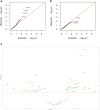Differential DNA methylation in recovery from shift work disorder
- PMID: 33536559
- PMCID: PMC7858604
- DOI: 10.1038/s41598-021-82627-0
Differential DNA methylation in recovery from shift work disorder
Abstract
The human DNA methylome is responsive to our environment, but its dynamics remain underexplored. We investigated the temporal changes to DNA methylation (DNAme) in relation to recovery from a shift work disorder (SWD) by performing a paired epigenome-wide analysis in an occupational cohort of 32 shift workers (25 men, age = 43.8 ± 8.8 years, 21 SWD cases). We found that the effect of vacation on DNAme was more prominent in the SWD-group as compared to controls, with respect to the amount of significantly differentially methylated positions (DMPs; Punadj < 0.05) 6.5 vs 3.7%, respectively. The vast majority (78%) of these DMPs were hypomethylated in SWD but not in controls (27%) during the work period. The Gene Ontology Cellular component "NMDA glutamate receptor" (PFDR < 0.05) was identified in a pathway analysis of the top 30 genes in SWD. In-depth pathway analyses revealed that the Reactome pathway "CREB phosphorylation through the activation of CaMKII" might underlie the recovery. Furthermore, three DMPs from this pathway, corresponding to GRIN2C, CREB1, and CAMK2B, correlated with the degree of recovery (Punadj < 0.05). Our findings provide evidence for the dynamic nature of DNAme in relation to the recovery process from a circadian disorder, with biological relevance of the emerging pathways.
Conflict of interest statement
The authors declare no competing interests.
Figures




References
Publication types
MeSH terms
Substances
LinkOut - more resources
Full Text Sources
Other Literature Sources

